Norvic Philatelics - GB New Stamps and Special Postmarks
A - Z of the United Kingdom - Part 2 : 10 April 2012 - includes
EUROPA/PostEurop issue.
A 26-stamp series depicting significant landmarks around the United
Kingdom, alphabetically.
When this was first revealed as part of the 2011 programme it sounded
like a good idea especially if it was issued as four sets of 6/7 or six sets
of 4/5. However, Royal Mail seem to have realised that a schedule like that
could not be accommodated alongside the regular stamp programme adn still
reach 'Z' by the time the Olympics visitors arrived, so the 26 1st class
stamps are being issued in two parts, with a set of 12 (A-L)
on 13 October 2011 and a further 14 stamps (M-Z) on 10 April 2012.
For each letter of the alphabet an iconic landmark of the UK is assigned,
ranging from ancient to modern and from spiritual to spectacular; but each
has an essential presence in the nation’s fabric. The stamps will be
printed in two sheets, each having 6 columns, which will enable multiples of
the same design/location to be purchased without the expensive of buying the
whole set/sheet.
The stamp policy team extensively researched UK gazetteers and drew up the
list of potential subjects which were supplied to the designer. Using a
mixture of specially commissioned and library photography the final line up
was assembled and agreed taking into consideration the need to represent
each of the four countries of the UK. In the caption table, locations
in Scotland have blue backgrounds, Ireland green, Wales red, and England
white.
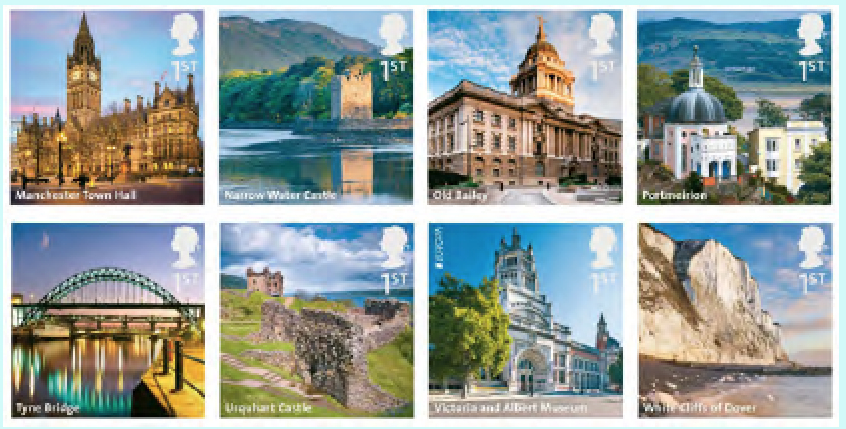 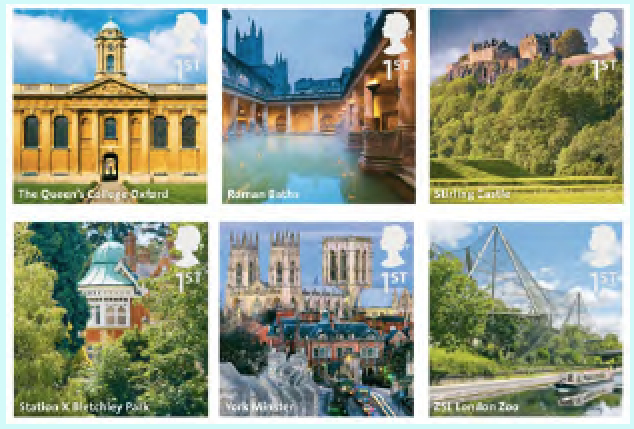
|
Manchester
Town Hall
|
Narrow Water
Castle
|
Old Bailey
|
Portmeirion
|
The Queen's
College Oxford
|
Roman Baths
|
Stirling
Castle
|
|
Tyne Bridge
|
Urquhart
Castle
|
Victoria and
Albert Museum
(Europa stamp)
|
White Cliffs
of Dover
|
Station X
Bletchley Park
|
York Minster
|
ZSL (London
Zoo)
|
|
The stamps in detail
Manchester Town Hall...
One of Britain’s greatest municipal buildings Manchester Town Hall is
a Victorian-era, Neo-gothic municipal building. The building functions as
the ceremonial headquarters of Manchester City Council and houses a number
of local government departments. Completed by architect Alfred
Waterhouse in 1877, the building features imposing murals by the artist
Ford Madox Brown depicting important events in the history of the city.
The Town Hall was rated by English Heritage as a Grade I listed building
in 1952 and the Town Hall Extension, completed in 1938, was Grade II
listed in 1974.
The
building
of Manchester Town Hall (1868 - 77) was undertaken because the
neo-classical Town Hall in King Street had become too small to house
the expanding business of the Council. A competition was held and
won by Alfred Waterhouse (1830 - 1905), mainly for his ingenious
planning. The site was an irregular triangle on which had to be
fitted a large hall, a suite of reception rooms and living quarters
for the Lord Mayor, as well as offices for all Corporation
departments, and a chamber for Council meetings. The exterior
is dominated by the 280-foot high clock tower. There are 24 bells in
the tower; the Great Hour Bell weighs over 8 tons and is called
Great Abel, named after Abel Heywood, Mayor at the time of the
official opening.
Narrow Water Castle
... is a famous tower house near Warrenpoint in Northern Ireland, located
on the County Down bank of the Clanrye River, which enters Carlingford
Lough a mile to the south. Narrow Water Castle was given into state care
in 1956 and is one of the finest 16th century buildings in Ireland. Narrow
Water Castle tower house and bawn is a state care historic monument in the
townland of Narrow Water, in Newry and Mourne District Council district.
Built for military purposes during the 1560s, Narrow Water Castle is a
typical example of the tower houses erected throughout Ireland from the
14th until the early 17th century. This form of building, normally
rectangular in plan and three or more storeys high, comprised a series of
superimposed chambers, with stairs, closets and latrines skilfully
contrived within the walls (which are 1.5 metres or five feet thick in
places) or sometimes contained in projecting angle turrets.
Old Bailey
The Central Criminal Court in England, commonly known as the Old Bailey
from the street in which it stands, is a court building in central London.
The present building dates from 1902, but it was officially opened on 27
February 1907. It was designed by E. W. Mountford and built on the site of
the infamous Newgate Prison, which was demolished to allow the court
buildings to be constructed. Above the main entrance is inscribed the
admonition, ‘Defend the Children of the Poor & Punish the Wrongdoer’.
King Edward VII opened the courthouse.
On the dome above the court stands a bronze statue of Lady Justice,
executed by British sculptor F. W. Pomeroy. She holds a sword in her right
hand and the scales of justice in her left. The statue is popularly
supposed to show blind Justice; however, the figure is not blindfolded.
The courthouse brochures explain that this is because Lady Justice was
originally not blindfolded, and because her ‘maidenly form’ is supposed to
guarantee her impartiality, which renders the blindfold redundant.
Portmeirion
... is a popular tourist village in Gwynedd, North Wales. It was designed
and built by Sir Clough Williams-Ellis between 1925 and 1975 in the style
of an Italian village and is now owned by a charitable trust and has
always been run as a hotel, which uses the majority of the buildings as
hotel rooms or self-catering cottages, together with shops, a cafe,
tearoom, and restaurant.
Portmeirion
has served as the location for numerous films and television shows, most
famously serving as The Village in the 1960s television show The
Prisoner. "PortmeiriCon"
is
the name given to ‘Six of One's’ regular Prisoner Conventions in the
hotel village of Portmeirion. The society has held these events
annually since 1977.
The Queen’s College Oxford
... founded 1341, is one of the constituent colleges of the University of
Oxford. Queen’s is centrally situated on the high street, and is
renowned for its 18th century architecture. The college was founded during
the 14th century by Robert de Eglesfield (d’Eglesfield), chaplain to Queen
Philippa of Hainault (the wife of King Edward III of England); hence its
name. Whilst the name of Queens’ College, Cambridge is plural, the Oxford
college is singular, and is written with the definite article.
The frontage was designed by Nicholas Hawksmoor, part of a substantial
rebuilding in the 18th century during which the library was built. The
medieval foundations, however, remain beneath the current 18th century
structure. Queen’s is notable for the beautifully clean, classical lines
of its buildings, unique among the largely gothic constructions that
predominate amongst Oxford colleges.
Roman Baths
... complex is a site of historical interest in the city of Bath.
The house is a well-preserved Roman site for public bathing. The Roman
Baths themselves are below the modern street level. There are four main
features: the Sacred Spring, the Roman Temple, the Roman Bath House and
the Museum holding finds from Roman Bath. The buildings above street level
date from the 19th century. The Baths are a major tourist attraction
and, together with the Grand Pump Room, receive more than one million
visitors a year, with 1,037,518 people during 2009. Visitors can see the
Baths and Museum but cannot enter the water. Water from the springs
is sold in The Pump Rooms.
The City
of Bath was inscribed as a World Heritage Site 25 years ago in
1987. The entire city is covered by the status, and the former
municipal city boundary forms the site boundary. Bath is one of
only a handful of cities with World Heritage Site status.
Stirling Castle
... is one of the largest and most important castles, both historically
and architecturally, in Scotland. The castle sits atop Castle Hill, an
intrusive crag, which forms part of the Stirling Sill geological
formation. It is surrounded on three sides by steep cliffs, giving it a
strong defensive position. Its strategic location, guarding what was,
until the 1890s, the farthest downstream crossing of the River Forth, has
made it an important fortifi cation from the earliest times.
Most of the principal buildings of the castle date from the 15th and 16th
centuries. A few structures of the 14th century remain, while the outer
defences fronting the town date from the early 18th century. Several
Scottish Kings and Queens have been crowned at Stirling, including Mary,
Queen of Scots, in 1543. There have been at least eight sieges of Stirling
Castle, including several during the Wars of Scottish Independence, with
the last being in 1746, when Bonnie Prince Charlie unsuccessfully tried to
take the castle. Stirling Castle is a Scheduled Ancient Monument, and is
now a tourist attraction managed by Historic Scotland.
Tyne Bridge
... is a through arch bridge over the River Tyne in North East England,
linking Newcastle upon Tyne and Gateshead. It was designed by the
engineering firm Mott, Hay and Anderson, who later designed the Forth Road
Bridge, and was built by Dorma Long and Co. of Middlesbrough. At the time
of its construction it was the world’s longest single span bridge. The
bridge was officially opened on 10 October 1928 by King George V and has
since become a defining symbol of Tyneside. It currently stands as the
tenth tallest structure in the city.
Urquhart Castle
... sits beside Loch Ness in Scotland along the A82 road, between Fort
William and Inverness. It is close to the village of Drumnadrochit. Though
extensively ruined, it was in its day one of the largest strongholds of
medieval Scotland, and remains an impressive structure, splendidly
situated on a headland overlooking Loch Ness. It is also near this castle
that the majority of Nessie (Loch Ness Monster) sightings occur.
It is not known precisely when the castle was built, but records show the
existence of a castle on this site from the early 13th century. It had a
colourful history through to the 17th century until it was largely
destroyed in 1692 by Williamite troops who had been holding the castle
against Jacobite forces. The intention was to ensure that the castle could
not become a Jacobite stronghold, an intention that was fully achieved as
the castle was never repaired and remained as a ruin. Subsequent
plundering of the stonework for re-use by locals, and natural decay,
further reduced the ruins.
Victoria and Albert Museum
... (often abbreviated as the V&A), set in the Brompton district of
The Royal Borough of Kensington and Chelsea, London, is the world’s
largest museum of decorative arts and design, housing a permanent
collection of over 4.5 million objects. It was founded in 1852 and
originally known as the South Kensington Museum. It changed its name in
1899, when it was named after Queen Victoria and Prince Albert, and has
since grown to cover 12.5 acres (51,000 m2) and 145 galleries. This
stamp has the EUROPA logo at the
top left.
The laying of the foundation stone to the left of the main entrance of
the Aston Webb building, on 17 May 1899, was the last official public
appearance by Queen Victoria. It was during this ceremony that the change
of name from the South Kensington Museum to the Victoria and Albert Museum
was made public.
White Cliffs of Dover
... are part of the North Downs formation. The cliff face, which
reaches up to 107 metres (351ft), owes its striking façade to its
composition of chalk accentuated by streaks of black flint. The cliffs
spread east and west from the town of Dover in the county of Kent, an
ancient and still important English port. The cliffs have great
symbolic value for Britain because they face towards Continental Europe
across the narrowest part of the English Channel, where invasions have
historically threatened and against which the cliffs form a symbolic
guard. Because crossing at Dover was the primary route to the continent
before air travel, the white line of cliffs also formed the first or last
sight of the UK for travellers.
Station
X Bletchley Park
Station X, a radio intercept station, is located in Bletchley Park, an
estate located in the town of Bletchley, in Buckinghamshire, where during
World War II, 12,000 people worked in total secrecy. It was the site
of the United Kingdom's main decryption establishment, the Government Code
and Cypher School (GC&CS), where cphers and codes of several Axis
countries were decrypted, most importantly the ciphers generated by the
German Enigma and Lorenz machines. The high-level intelligence produced at
Bletchley Park codenamed Ultra, provided crucial assistance to the Allied
war effort. Sir Harry Hinsley, a Bletchley veteran and the official
historian of British Intelligence in World War II, said that Ultra
shortened the war by two to four years and that the outcome of the war
would have been uncertain without it.
Block
C,
a building at Bletchley Park used to break the Enigma Code, which
contributed to the allied victory in the Second World War, has been
given Grade II listed status.
Post Office engineers played a vital part in the code breaking
activity at Bletchley Park during the war, from maintaining vital
communications such as teleprinters to building code breaking devices,
including work on Colossus computers, the world’s first programmable
computer, for which we can thank Tommy Flowers, the Post Office engineer
for his vital work. So secret was the work that after the war Churchill
ordered the computers to be dismantled and destroyed. Alan
Turing devised a number of techniques for
breaking German ciphers, including the method of the bombe, an
electromechanical machine that could find settings for the Enigma
machine. The bombe was featured in the February Britons
of Distinction issue, to mark Turing’s centenary.
York Minster
... is one of the largest Gothic cathedrals in Northern Europe. It is
the seat of the Archbishop of York, the second-highest office of the
Church of England, and cathedral for the Diocese of York; it is run by a
dean and chapter under the Dean of York. Its formal title is The Cathedral
and Metropolitical Church of St Peter in York. The title ‘Minster’ is
attributed to churches established in the Anglo-Saxon period as missionary
teaching churches. It has a very wide Decorated Gothic nave and chapter
house,
a Perpendicular Gothic choir and east end and Early English north and
south transepts. The nave contains the West Window, constructed in 1338,
and over the Lady Chapel in the east end is the Great East Window
(finished in 1408), the largest expanse of medieval stained glass in the
world. In the north transept is the Five Sisters Window, each lancet being
over 16 metres (52 ft) high. The south transept contains a famous rose
window.
ZSL London Zoo
... is the world’s oldest scientific zoo. It was opened in London on 27
April 1828, and was originally intended to be used as a collection for
scientific study. It was eventually opened to the public in 1847. Today it
houses a collection of 755 species
of animals, with 16,802 individuals, making it one of the largest
collections in the United Kingdom.
It is
managed under the aegis of the Zoological Society of London (established
in 1826), and is situated at the northern edge of Regent's Park, on the
boundary line between City of Westminster and Camden (the Regent's Canal
runs through it). As well as being the first scientific zoo, ZSL London
Zoo also opened the first Reptile house (1849), first public Aquarium
(1853), first insect house (1881) and the first children's zoo
(1938). The
stamp
shows the Snowdon Aviary, built between 1962 and 1964 by Tony
Armstrong-Jones (Lord Snowdon), Cedric Price and Frank Newby. Its
frame was pioneering in that it made use of aluminium, and in that
it was an example of a kind of engineering that uses tension to
support its structure.

Composite Stamp Sheet. This sheet
contains all 26 stamps in the two-part set, with pictures of the seats of
government in the corner spaces.
Top Left: Houses of Parliament, London; top right: Welsh Assembly
building, Cardiff; lower left: Scottish Parliament building, Edinburgh;
lower right: Stormont Castle, Belfast.
Technical details: The 35mm square stamps are designed by Robert
Maude and Sarah Davies. They are printed in lithography by Cartor
Security Printing, perf 14½, with all-over phosphor. The stamps are in
three sheets of 6 x 5 rows, being M-R, S-X, and YZYZYZ. The format
enables columns of 5 stamps of the same design to be purchased. The
Victoria and Albert Museum stamp is issued in conjunction with PostEurop
as this year's Europa stamp.
Image Acknowledgements: Manchester
Town Hall, Stirling Castle, Urquhart Castle and York
Minster photography © Joe Cornish; Narrow
Water
Castle, Portmeirion, Roman Baths, Victoria and Albert Museum and
White Cliffs of Dover photography
© David Noton; Old Bailey
photography © Eric Nathan/Alamy; The
Queen’s College Oxford and ZSL
London Zoo photography © Charlie Waite; Tyne
Bridge photography © Edmund Nagele/Alamy; Station
X Bletchley Park photography © Rolph Gobits
Details of the composite sheet awaited. The stamp and
postmark images are Copyright 2012 by Royal Mail.
Products issued:
Set of 14 mint stamps
Presentation Pack
First Day Covers (Royal Mail will produce two covers, with 6 & 8
stamps on)
Set of 14 stamp cards.
Composite Stamp Sheet.
Special Postmarks
Postmarks available for the day of issue will be shown here, these
may not be to scale. More postmarks may be added later.
These postmarks cannot be obtained to order after 10 April.
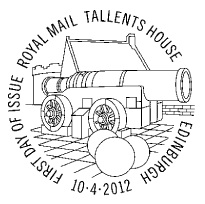
|
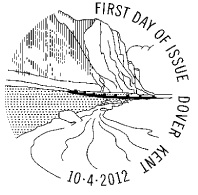
|
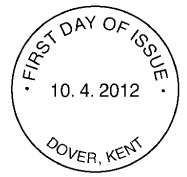
|
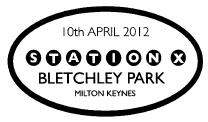
|
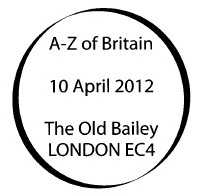
|
Ref FD1223
Official Philatelic Bureau FDI. |
Ref FD1224
Official Dover FDI postmark. |
Ref FD1224NP
Official Dover non-pictorial FDI postmark |
Ref L124531 STATION X
Bletchley Park, Milton Keynes
|
Ref L12452 A-Z of Britain The Old Bailey London EC4 |
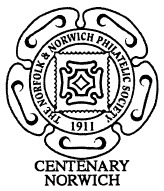 |
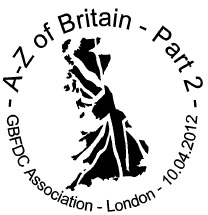
|
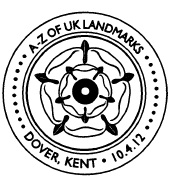
|
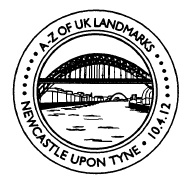
|
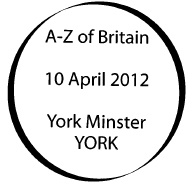 |
Ref L12295 The
Norfolk & Norwich Philatelic Society Centenary, Norwich
(In use 13 Oct 11 - 12 April
12) |
Ref L12451
GBFDC Association, London
|
Ref L12463
Dover, Kent
|
Ref N12467
Newcastle Upon Tyne
|
Ref N12455
York Minster, York
|
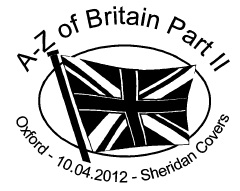
|
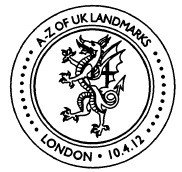
|
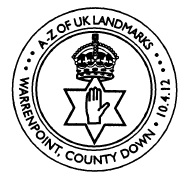
|
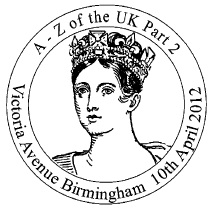
|
Five postmarks marking the Centenary of the RMS Titanic were also
available on 10 April |
Ref L12462 Oxford
|
Ref L12465 London
|
Ref S12470
Warrenpoint, County Down
|
Ref M12477
Victoria Avenue, Birmingham
|
|
If
you would like to be contacted when this page is updated please use the
ChangeDetection panel alongside the stamp image; any other enquires
please email
us.
NB: emails will usually be acknowledged in 1-2
days. If you do not receive an acknowledgement please email us from
a different address (eg hotmail, gmail).
This page updated 14 April 2012
Instant
Printing Prices from Webmart
















